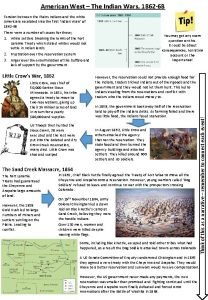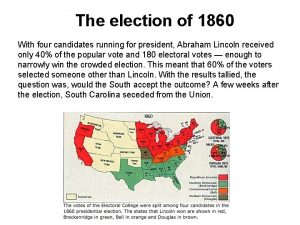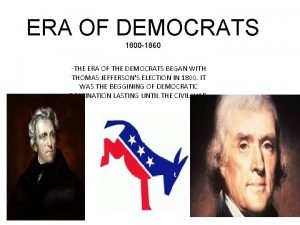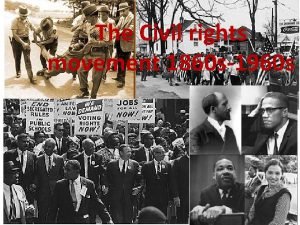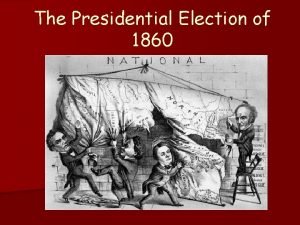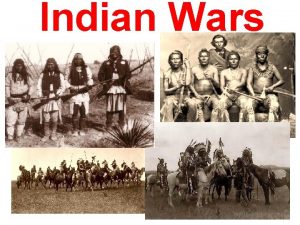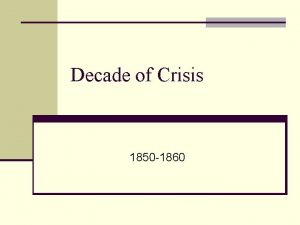Indian Wars 1860 1890 1850 approximately 250 000




























- Slides: 28

Indian Wars: 1860 -1890

1850: • approximately 250, 000 Indians lived on the great plains • 25, 000 whites lived west of Mississippi River • 60, 000 bison Reasons for westward expansion: -Manifest Destiny -Gold/resources -Homestead Act -Railroads -Overcrowding in East -Problems in Europe Expansion led to conflict with people who were already there

v. Originally much more lenient to plains Indians v. Generally agreed to share land v. Some reservations, but usually good land v. Later changed to forced movement v. Extermination v. Assimilation

• Take away the food source from the Native American and they will be forced to submit and go to the reservations.

Dakota Sioux War of 1862 • As of 1851, Santee Sioux in Minnesota had agreed to live on Reservation near Minnesota river • Relations were generally good • 1862, crops were destroyed by insects and government annuities Never came- with winter approaching, Sioux were going to starve • August, 1862, Chief Little Crow led his warriors on a rampage. Killing all whites in the area (400 the first day) • 800 killed total and 30, 000 whites left Minnesota • September, 1862 - Army reinforcements arrive and put down the Rebellion • First real outbreak of violence on plains between whites and Indian

Dakota Sioux War of 1862 Siege of New Ulm

Sand Creek- 1864 • 1863: Cheyenne in Colorado begin raiding settlements after Government supplies failed to arrive • Citizens of Colorado fear for their safety and Governor creates a militia to find these raiding parties • John Chivington is selected as leader • November, 1864: Chivington attacks Black Kettle’s Cheyenne Village on Sand Creek reservation and kills nearly everyone in it • Horrific atrocities are committed but Cheyenne are now contained (for the moment)

Colonel John Chivington “Kill and scalp all, big and little!” Sand Creek, CO Massacre November 29, 1864

Red Cloud’s War- 1866 • Gold is discovered in Montana in 1863 and miners began moving into the area • Passed through Sioux country to get there and Sioux began to attack them • Military brought in to defeat the Lakota, led by Red Cloud and his warriors (one of whom was Crazy Horse) • Fetterman massacre • After two years of fighting, U. S. conceded victory to the Sioux- noteworthy for 2 reasons: • Only WAR ever won by Indians against U. S. • Sioux were guaranteed all of Western S. D. in treaty, including Black Hills; also free to roam in unpopulated areas

Gold! Gold discovered in the Black Hills in 1874. v Govt. tries to purchase the land, but the Sioux refuse. v v Gold fever and miners refuse to respect Sioux land…. . v Conflict erupts!

Sitting Bull and Crazy Horse v Sitting Bull (Hunkpapa Sioux) and Crazy Horse (Ogalala Sioux) were two chiefs who refused to sign the treaty. v All Indians ordered back onto reservation v "One does not sell the earth upon which the people walk" Crazy Horse

Little Big Horn River, Montana - 1876 George Armstrong Custer was sent to force the Sioux, Cheyenne and Arapaho back to their reservations (part of a larger force). v v He was in command of the 7 th Calvary. v June 26, 1876

The Battle of Little Big Horn 1876 v. He was heavily outnumbered and trapped. v. Custer & all 220 of his men died. v“Custer’s Last Stand” outraged Americans and led to govt. retribution. v. The Sioux and Cheyenne were crushed in the following years. v. Best and worst thing for N. A.

Painting-Little Bighorn

Memorial-Little Bighorn

Chief Joseph I will fight no more forever! 1877 - led 800 Nez Perce over 1700 miles in 3 months trying to escape to Canada; chased by 2000 soldiers; caught 40 miles from border

Geronimo, Apache Chief: Hopeless Cause 1880’s- led series of raids against settlers in Southwest Fought for years before being captured Chiracahua Apache- his surrender in 1886 marked the end of Indian resistance in Southwest


Oklahoma Land Rush of 1889 v This opened the Indian Territory to the settlers. What used to be Indian Territory out west was opened to Americans once Indians are finally on the reservation. v v State of Oklahoma would be formed.

Dawes Act of 1887 v. Quicker Americanization §Assimilate, mainstreamed and absorbed into US society §Adopt Christianity and White education §Individual land ownership v. Abandon tribe, culture and become farmers v. Male claimed 160 acres of land v. Children would be sent to Indian schools v. Farm land for 25 years- then they

The Ghost Dance Movement -1890 Paiute medicine man Wovoka promised the return of the buffalo and Indian way of life. v v The religion prophesied the end of the westward expansion of whites and a return of Indian land. The ritual lasted five successive days, being danced each night and on the last night continued until morning. v Hypnotic trances and shaking accompanied this ceremony, which was supposed to be repeated every six weeks. v

The Ghost Dance Movement -1890 Ghost Dance movement spread to the Sioux v They religiously danced even after they were told to stop by reservation authorities. v Military went to arrest Sitting Bull, where he was killed. v Many Sioux followers left the reservation and joined Bigfoot’s group, who were now on the run v

Telegram to Washington, D. C. Nov. 15, 1890 "Indians are dancing in the snow and are wild and crazy. I have fully informed you that the employees and the government property at this agency have no protection and are at the mercy of the Ghost Dancers. . We need protection and we need it now. . . nothing [short] of 1000 troops will stop this dancing. " Dr. Daniel F. Royer, Agent, Pine Ridge Agency Ghost Dance 4

Indian warriors fighting against the US wore Ghost Shirts which were to stop the penetration of American soldiers bullets……It gave them supernatural powers as was believed……… Ghost Shirt

Battle of Wounded Knee – Dec. 1890 7 th Calvary caught Bigfoot’s people near Wounded Knee, SD They attempted to confiscate all weapons when a shot was fired. v v

Battle of Wounded Knee – Dec. 1890 v Violence erupted, 300 Indians and 25 whites lay dead. v This is the last of the Indian conflicts. Chief Big Foot

Battle of Wounded Knee – Dec. 1890 • The dead of Big Foot's people were buried in a mass grave. The still frozen stiff bodies were dumped unceremoniously into the hole. • The United States handed out over twenty Congressional Medals of Honor to soldiers of the Seventh Cavalry who had participated in the battle.

v. Helen Hunt Jackson (1830 -1885), activist for Native American rights and author of Century of Dishonor was published in 1881. v. Jackson also began work on a book condemning the government’s Indian policy and its record of broken treaties. v. When Jackson sent a copy to every member of Congress with the following admonition printed in red on the cover: "Look upon your hands: they are stained with the blood of your relations. " To her disappointment, the book had little impact.
 Express 602200 in scientific notation.
Express 602200 in scientific notation. 97 000 000 in scientific notation
97 000 000 in scientific notation 33 900 000 in scientific notation
33 900 000 in scientific notation Albertine og et dukkehjem
Albertine og et dukkehjem Billions8
Billions8 0,000 0,000 0,000
0,000 0,000 0,000 The indian wars 1862-68
The indian wars 1862-68 Gold rush 250 000
Gold rush 250 000 Border states in 1860
Border states in 1860 Values feeling and intuition over reason
Values feeling and intuition over reason Apush 1820 to 1860
Apush 1820 to 1860 South africa 1860
South africa 1860 South carolina 1860
South carolina 1860 Aspirateur daniel hess
Aspirateur daniel hess Map of 1860
Map of 1860 What era was the 1800
What era was the 1800 1860
1860 The romantic period in american literature
The romantic period in american literature Election of 1860 pie chart
Election of 1860 pie chart W.w. norton
W.w. norton Decreto 1860 de 1994
Decreto 1860 de 1994 American romanticism 1800 to 1860 worksheet answers
American romanticism 1800 to 1860 worksheet answers Definition
Definition American reform movements between 1820 and 1860
American reform movements between 1820 and 1860 American romanticism 1800 to 1860 worksheet answers
American romanticism 1800 to 1860 worksheet answers Agnosia associativa
Agnosia associativa The population of smallville in the year 1890 was 6250
The population of smallville in the year 1890 was 6250 London 1890 rizal
London 1890 rizal Kaligirang pangkasaysayan ng el filibusterismo 1891
Kaligirang pangkasaysayan ng el filibusterismo 1891






